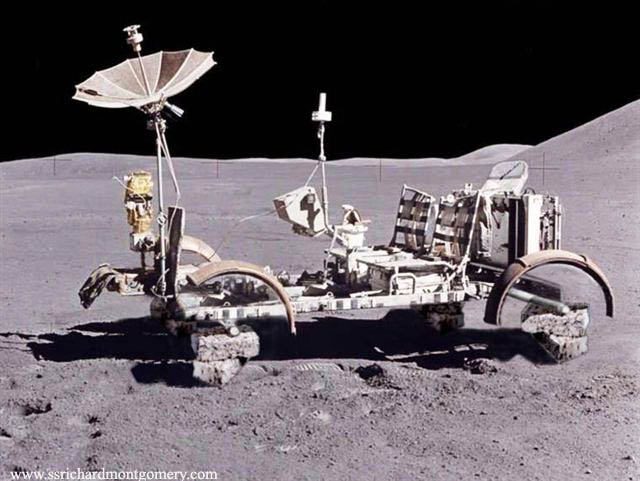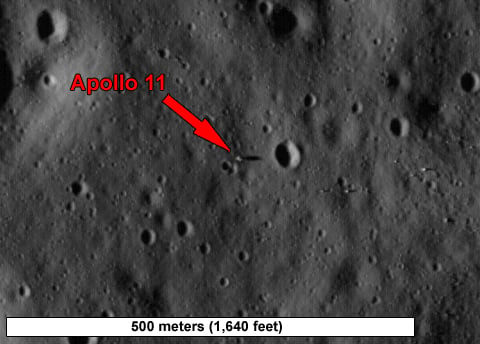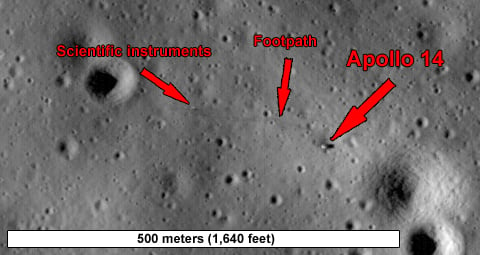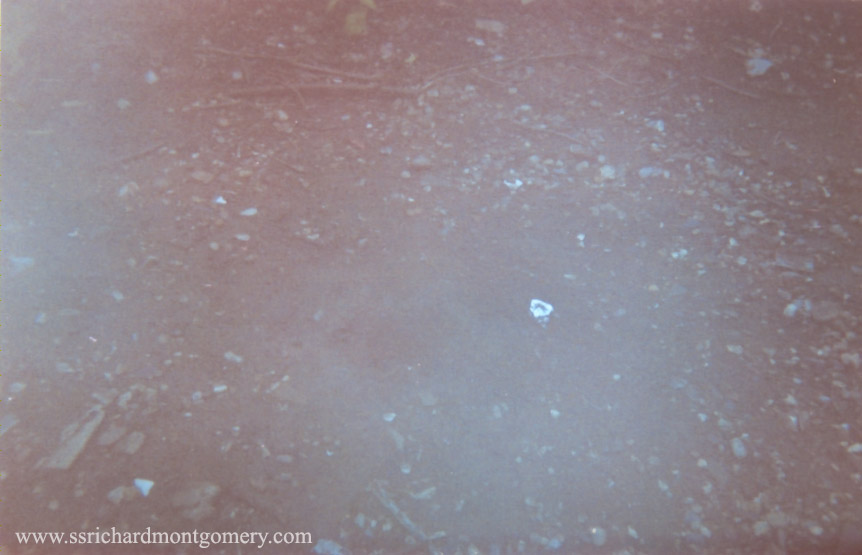Above and Beyond:
The Apollo Space Race to the Moon
History Today June 2009 | Volume: 59 Issue: 7 | Page 14-20 | Words: 4174 | Author: Balogh, Andr?
From:
http://www.historytoday.com/MainArticle.aspx?m=33482&amid=30286235
In 1969 men set foot on the Moon for the first time. The Apollo space programme that put them there was the product of an age of optimism and daring very different from our own, argues Andr? Balogh.
<TEXT><TABLE cellSpacing=0 cellPadding=0 width=210 align=left border=0><TBODY><TR><TD colSpan=3>
 </TD></TR><TR><TD width=5>
</TD></TR><TR><TD width=5>
</TD><TD class=dmPictureText style="FONT-WEIGHT: bold" width=200>The Apollo 11 Moon landing on the cover of Life magazine, Aug 11, 1969, featuring a photo of Buzz Aldrin (Getty / TimeLife)
</TD><TD width=5>
</TD></TR></TBODY></TABLE></TEXT>It is 40 years since Neil Armstrong took his ?giant leap for mankind? on the early summer morning of July 20th, 1969. It was the high point of a vast and expensive space programme initiated by <TEXT><TEXT>President John F. Kennedy</TEXT></TEXT> in the early 1960s which ended when Apollo 17?s lunar module lifted off from the Moon on December 14th, 1972. In just under three and a half years, 12 US astronauts walked on the Moon,drove around in their Moon buggy and thrilled television viewers around the world with their barely believable pantomime on a celestial body 236,000 miles from <TEXT><TEXT>Earth</TEXT></TEXT>.
The end came suddenly and space has not captured the public?s attention in the same way since, except, in a very different way, in response to the tragedies of the space shuttles Challenger in 1986 and Columbia in 2003. The Apollo programme had to compete for attention with other major events: the large-scale unrest in the US over civil rights and against the Vietnam war; then, less than a year after the last Apollo mission, the Watergate scandal which brought down President Nixon. Throughout these upheavals, astronauts walked on the Moon, flew the American flag and displayed the might of US technology and resources to massive global audiences in what remains, arguably, the greatest technical achievement of mankind.
The Apollo programme was a child of the Cold War. The technological stakes had been raised by theSoviet Union's launch of Sputnik 1, the first Earth-orbiting artificial satellite, in October 1957. Apollo was the response of a technically fast-developing and confident nation with bewildering reserves of money and talent. It was also symbolic of a different mentality, optimistic, can-do and willing to confront the most awe-inspiring challenges. As Kennedy proclaimed: ?We choose to go to the Moon in this decade and do the other things, not because they are easy, but because they are hard.?
Soviet firsts in space sustained panic in the US over a perceived ?missile gap? and the launch of Sputnik ignited a space race which saw the two superpowers building and attempting to launch a variety of rockets that could double as Intercontinental Ballistic Missiles (ICBMs). We say attempting, because in those early years rockets were less than reliable, with spectacular and very public failures on the launch pads or shortly afterwards at what became Cape Kennedy in Florida (it reverted to its orginal name Cape Canaveral in 1973). It is now known that the early Soviet rocket programme was also punctuated by failures but at that time such setbacks were concealed by the secrecy surrounding the Baikonur space complex in what is now Kazakhstan.
<TEXT><TABLE cellSpacing=0 cellPadding=0 width=260 align=right border=0><TBODY><TR><TD colSpan=3>
 </TD></TR><TR><TD width=5>
</TD></TR><TR><TD width=5>
</TD><TD class=dmPictureText style="FONT-WEIGHT: bold" width=250>Soviet Union cosmonaut Yuri Gagarin becomes the first man in orbit, Apr 12, 1961 (Getty / Popperfoto)
</TD><TD width=5>
</TD></TR></TBODY></TABLE></TEXT>Yet Soviet scientists were soon confident enough to launch Yuri Gagarin into space for a single orbit of the Earth in his Vostok capsule on April 12th, 1961. It marked a new phase in the space race, demonstrating not only immense confidence but also the powerful appeal to the public of men in space. While NASA (National Aeronautics and Space Administration), the then young and vigorous agency of US government in charge of the space effort, prepared to match Gagarin?s feat, it was clear that the superiority of the US could only be truly demonstrated by a qualitatively and quantitatively more spectacular achievement. The announcement of the Apollo programme to land a man on the Moon made by President Kennedy on May 25th, 1961, came just six weeks after Gagarin?s flight and was intended to neutralise and ultimately trump the Soviet achievement.
Kennedy?s speech to a joint session of Congress, always a solemn occasion, stated: ?First, I believe that this nation should commit itself to achieving the goal, before this decade is out, of landing a man on the Moon and returning him safely to the Earth. No single space project in this period will be more impressive to mankind, or more important in the long-range exploration of space; and none will be so difficult or expensive to accomplish.?
This was to be the space project of the decade and would not be surpassed by any other country. It was to be a ?giant step? that would convince the world and reassure the American public that the United States, once moved, could do what nobody else could do. This point, the first of Kennedy?s proclamation, recognised that the most important and most convincing force in international politics is the perception of superiority. Gagarin?s single round-the-world orbit was impressive as it demonstrated the confidence of the Soviet engineers in the reliability of their rocket technology. It certainly impressed the people in the West and it increased the justified fear of the capability of Soviet missiles. This advantage was pushed to its limits the following year by the Soviet leadership, leading to the Cuban missle crisis.
Kennedy?s pronouncement that Americans would go to the Moon and back was an altogether different proposition, implying a much greater and broader based technical capability than lay behind Gagarin?s flight. The claim to open space for exploration by sending US astronauts to the Moon was the limit of the achievable in manned space exploration.
Kennedy claimed that the goal would be unmatched in its difficulty, an un-paralleled technical and human challenge. By the time of his announcement, NASA had been working hard on a broad technical front to build up a credible space programme from scratch in only three years.
This involved a vast and diverse effort, the use of small, suborbital rockets that could take scientific payloads to the edge of space but not into orbit, several medium-sized rockets for Earth-orbiting spacecraft (the best candidates as warhead-carrying missiles) and the large Saturn 1 rocket that was designed under the leadership of Werner von Braun, one of the leaders of Nazi Germany?s V2 rocket weapon programme. At the same time, spacecraft started exploring the Earth?s own space environment, leading to the discovery of the radiation belts named after James van Allen and the magnetosphere, the magnetic bubble around the planet that protects it from the direct effects of solar wind. These early discoveries were generally made in parallel by both Soviet and American scientists, though the findings of the more open US experts became much better known than those in the pay of the secretive Soviet regime.
NASA became focused on finding the technical solutions to the challenge of taking astronauts to the Moon and returning them safely. The key technical decision concerned the means of carrying them there and back. There were a number of options proposed but the one selected in the end and ultimately carried out involved the use of a vast launcher that did not exist at the beginning of the project, which was to carry all that was needed to the Moon, land a portion of it which would then be able to take off from the Moon and rendezvous with a pod that could carry the astronauts back to a safe splashdown in the sea. This solution presented very serious risks: astronauts would be required to dock in lunar orbit when such a rendezvous had not even been attempted in earth orbit. But those in NASA who proposed it were right to point out that technically this was the only scenario that could be carried out by the deadline.
<TEXT><TABLE cellSpacing=0 cellPadding=0 width=210 align=left border=0><TBODY><TR><TD colSpan=3>
 </TD></TR><TR><TD width=5>
</TD></TR><TR><TD width=5>
</TD><TD class=dmPictureText style="FONT-WEIGHT: bold" width=200>Apollo II Saturn 5 rocket launched from the Kennedy Space Centre, Florida, Jul 16, 1969 (Getty / Hulton)
</TD><TD width=5>
</TD></TR></TBODY></TABLE></TEXT>And so the vast technical might of the United States was put into gear to design, test and carry out the project. A rocket, the Saturn V, was built, based on the Saturn 1A rocket design, a monument to man?s technological achievement that when assembled and ready for launch was about the height of St Paul?s Cathedral. The Apollo command and service module, as well as the lunar module, were built and tested starting in late 1961 to a very tight schedule. There was tragedy on the way: an accident involving the command module of Apollo 1 during pre-flight tests on January 27th, 1967 killed astronauts Gus Grissom, Ed White (the first US astronaut to walk in space) and Roger Chaffee. Design changes were introduced and by Christmas 1968 Apollo 8 was capable of flying to and around the Moon and back to Earth. Though this flight was made without the proposed lunar landing module, Apollo 8 was able to test many aspects of the ultimate flight scenario. Orbiting the Moon on Christmas Eve, its three astronauts made an emotional live television broadcast of greetings to the Earth.
Apollo 9 was the first flight, in March 1969, of the complete Apollo package in Earth orbit to test all aspects of the final scenario except the Moon landing itself. Then came Apollo 10 in May 1969, a full-scale dress rehearsal. The lunar module was piloted to within 15km of the lunar surface, rejoining the command module in orbit and then returning to the Earth. The two astronauts who got so close were Thomas Stafford, later to command the American crew in the historic Apollo-Soyuz joint test-flight, and Ed Cernan, who later commanded the Apollo 17 flight, becoming the ?last man on the Moon? as he rejoined the lunar module for the final ascent. An iconinc image,Earthrise,was taken by the crew of Apollo 10 as it orbited the Moon.
Apollo 11 was launched on July 16th, 1969 with Neil Armstrong, Buzz Aldrin and Michael Collins as the first crew to fly to the Moon and land two astronauts upon it. Armstrong and Aldrin proceeded to plant the American flag into the lunar regolith (the upper layer that consists of rock fragments and dust). Apollo 11 carried a small array of scientific instruments, among them an aluminium sheet used to collect debris from the solar wind. The astronauts then rendezvoused successfully in Moon orbit and returned to a safe splashdown and quarantine on Earth. Kennedy?s commitment was fulfilled.
There were in all six successful Moon landings in a way each more successful than the previous ones, with increasingly higher quality television images and the enduring image of the Moon buggy racing across the lunar landscape. Even the flight of Apollo 13, the aborted mission that led to the famous phrase ?Houston, we have a problem?, should be remembered for the remarkable technical recovery from a desperate situation, the stuff of Hollywood, which it later became.
<TEXT><TABLE cellSpacing=0 cellPadding=0 width=235 align=right border=0><TBODY><TR><TD colSpan=3>
 </TD></TR><TR><TD width=5>
</TD></TR><TR><TD width=5>
</TD><TD class=dmPictureText style="FONT-WEIGHT: bold" width=225>Insignia of the ill-fated Apollo 1, the crew lost their lives in a launch pad fire, Jan 27, 1967 (Getty / Timelife)
</TD><TD width=5>
</TD></TR></TBODY></TABLE></TEXT>While the Apollo programme was wholly motivated by strategic political considerations, the Moon landings also brought important scientific results through observations made on the Moon?s surface and by bringing back a total of about 368kg of lunar samples. Scientists began to understand from these the structure and past history of the Moon, almost completely unknown before, by dating the craters and the maria that cover the Moon?s surface. The findings of the Apollo mission also
support the scenario in which an early version of the Earth was impacted upon by a Mars-sized body that led to enough material being ejected to form the Moon during the dawn of the Solar System.
What about the bill? Kennedy did not put a figure on the cost when announcing the programme (that would have spoilt the effect of the speech) but recognised that no other space project ?will be so ? expensive to accomplish?. The cost was indeed very high: NASA?s budget shows a peak (in 1969 values) of close to $4.5 billion in 1966, with similar figures in the immediately surrounding years, of which about two thirds were devoted to the Apollo programme. Official figures show that the original budget for Apollo was estimated to be about $23 billion and ended up costing between $20 and $25 billion, thus being, seemingly, on budget, a remarkable feat considering its vastness, complexity and novelty. (These costs in current terms would add up to around $150 billion.) Any uncertainty in judging the final costs is due to the abandonment of three further Apollo flights and the difficulty of accounting fully for the expansion in NASA centres when the infrastructure put in place in the 1960s continued to serve the needs of other NASA programmes well beyond Apollo. This financial effort is amazing when the other, simultaneous commitments of the US are taken into account, not least waging a war in south-east Asia with a fully equipped army of almost half-a-million men and women.
The Apollo programme certainly fulfilled one of its principal aims: showing the Soviet Union who was boss in space and, by implication, frontline technology directly transferable to armaments. The <TEXT><TABLE cellSpacing=0 cellPadding=0 width=310 align=left border=0><TBODY><TR><TD colSpan=3>
 </TD></TR><TR><TD width=5>
</TD></TR><TR><TD width=5>
</TD><TD class=dmPictureText style="FONT-WEIGHT: bold" width=300>President Nixon greets the crew of Apollo 11 during quarantine after their return to Earth, July 24, 1969 - from left: Neil Armstrong, Michael Collins, Buzz Aldrin (Getty / Hulton)
</TD><TD width=5>
</TD></TR></TBODY></TABLE></TEXT>relative ease with which the US paid for the programme, as living standards reached heights never seen before, must have impressed the Soviet leadership and their allies. As a weapon of the Cold War, Apollo was a total success, fulfilling its political aim of showing the superiority of the capabilities of the United States to the world. Almost incidentally, the race to the Moon (never seriously joined by the Soviets) was won.
By the time Apollo 17, the final mission, was launched on December 7th, 1972, the importance of space as a battle-ground in the Cold War was fading. It was generally accepted that, whatever the relative capabilities of missiles with thermonuclear warheads, there was enough weaponry on both sides, East and West, to destroy the world several times over, regardless of who fired first. (The later "Star Wars" programme <TEXT>initiated by President Reagan in the 1980s</TEXT></TEXT> was a much less spectacular, primarily technological effort, kept well under wraps by the United States in order to keep ahead in the arms race.) NASA budgets started shrinking; there was a new programme, the Space Shuttle, demanding resources, so Apollo 18, 19 and 20 were cancelled.
One of the Saturn 5 rockets was reused to launch the first ever space station, Skylab, with myriad scientific instruments on board and scientists among its crew. Its achievements were far from negligible but remain largely in the domain of science. One discovery, made by a solar telescope carried on Skylab, revealed that the ebbing and waning of the large dark areas of the Sun?s atmosphere, called coronal holes, affected climatic change on Earth.
While the Shuttle programme progressed more slowly and cost more than expected, there was a decline in space activity, with no manned programmes of any sort, let alone anything with the appeal of Apollo. Even the arrival of the Space Shuttle in the early 1980s lacked its excitement. The scientific achievements were more consistent and brought results to a larger number of scientists than Apollo had done, in most part thanks to the European Spacelab module which was carried into space on the Shuttle. Then, on January 28th, 1986 came the Challenger accident that made NASA reconsider its strategy and remove the Shuttle from one of its roles, that of launching satellites. The accident also brought to light the fact, obvious to some well before then, that the risks faced by the Space Shuttles were considerably higher than previously advertised to the public and the media and believed even by some of the managers in NASA, if not those with engineering or scientific backgrounds. (This point was tragically reinforced in February 2003 when the Space Shuttle Columbia broke up during re-entry into the atmosphere.)
What of recent and current manned space programmes? The long success and occasional drama of the Russian Mir space station over the 15 years of its lifetime, from the first launch in 1986 to the controlled re-entry into the atmosphere in 2001, provided valuable experience of long-duration space missions. The International Space Station (ISS), currently in orbit, is a superior version of the Mir space station, with large laboratories full of expensive equipment exploring the influence of gravity on a wide range of natural phenomena including its effect on blood flow, as well as attempts to grow protein crystals in space, which prompted major advances in our understanding of the structures of complex biomolecules.
<TEXT><TABLE cellSpacing=0 cellPadding=0 width=260 align=right border=0><TBODY><TR><TD colSpan=3>
 </TD></TR><TR><TD width=5>
</TD></TR><TR><TD width=5>
</TD><TD class=dmPictureText style="FONT-WEIGHT: bold" width=250>Footprint on the Moon from the Apollo 11 mission, July , 1969 (NASA)
</TD><TD width=5>
</TD></TR></TBODY></TABLE></TEXT>But the ISS has taken considerably longer to develop than originally expected. It also suffered from operational restrictions when, after the Columbia accident, the Space Shuttle fleet was reduced in numbers and the launch frequency of the remaining three (Discovery, Atlantis and Endeavor) was also cut. Without the help, cooperation and capability of the Russian Soyuz launcher and vehicle it would not have been possible to maintain the ISS. Times have changed indeed since the days of the Cold War, the space race and Apollo.
The Shuttle fleet is due to be retired in 2010, leaving only the ISS, supplied with crew and goods by Soyuz and the newly developed unmanned European cargo ship, the Automated Transfer Vehicle. This restricts its use, in particular because of the restrictions in crew numbers. The maintenance costs of the ISS are very high and, as its usefulness seems to be questionable, this vast investment in space (commensurate with the cost of the Apollo programme) will no longer be exploited. So what comes next?
It seems that the Moon is again on the agenda. Long neglected in favour of the exploration of Mars, a return to the Moon now seems likely in the next decade or two. There are firm plans in the United States: the preliminaries of the programme for a new launcher and new crew vehicle are now financed at a level compatible with a realistic schedule. While both presidents Bush set an eventual goal of landing men on Mars, the more recent initiative envisages a first phase, the return of astronauts to the Moon and even a more-or-less permanently inhabited Moon base. Of course such ambitious plans, due to their length, are at the mercy of changing political priorities and personalities as well as changing global political and economic circumstances. However, it is probably right to be optimistic about a sustained, long-term effort to colonise the Moon in some sense, even if this is not very clear to even the most ardent advocates of manned spaceflight. There are other ambitious nations, naturally the Russians, who have both past experience and capabilities and potentially vast resources, but also the Chinese, the Japanese and the Indians, have all recently sent unmanned scientific spacecraft to the Moon. Possibly the next realistic step will be robotic landers to carry out experiments locally and then to return a larger variety of samples than was available from the Apollo missions.
<TEXT><TABLE cellSpacing=0 cellPadding=0 width=260 align=left border=0><TBODY><TR><TD colSpan=3>
 </TD></TR><TR><TD width=5>
</TD></TR><TR><TD width=5>
</TD><TD class=dmPictureText style="FONT-WEIGHT: bold" width=250>James Irwin on the Apollo 15 mission, Aug 1971 (Getty / Hulton)
</TD><TD width=5>
</TD></TR></TBODY></TABLE></TEXT>And then to Mars? This is highly unlikely. Even though no less a figure than Neil Armstrong has been quoted recently as saying that the challenges to land on Mars are not as difficult as the Apollo pioneers faced, a manned mission to Mars seems beyond the reach of affordable technology and political will (not least because of the financial resources that would be required). What was possible in the 1960s to a technically less advanced generation may be out of reach to this and future generations, simply because of the change in attitudes and priorities and the vast increase in the thresholds of risk that are now seen as acceptable. This is one overhead that the Apollo programme did not have to face. Apollo could not be reproduced in the early 21st century, simply because the world we live in is so utterly different from that of only 40 or 50 years ago; sights have lowered as fears have increased. But the Apollo programme happened, men really walked on the Moon and drove their buggies over the lunar landscape and 40 years on we have to recognise the achievement that crowned an undertaking made to that very different world. It remains an inspiration.
Andr? Balogh is Emeritus Professor of Space Physics at Imperial College London and Director of the International Space Science Institute in Bern, Switzerland.




 </TD><TD vAlign=top align=middle width=650>
</TD><TD vAlign=top align=middle width=650>
 </TD><TD width=20>
</TD><TD width=20>

 </CENTER><CENTER sizset="5" sizcache="10">
</CENTER><CENTER sizset="5" sizcache="10"> </CENTER><CENTER sizset="6" sizcache="10">
</CENTER><CENTER sizset="6" sizcache="10">

 Footprint on the Moon: Moondust? Or just plaster?
Footprint on the Moon: Moondust? Or just plaster? 



